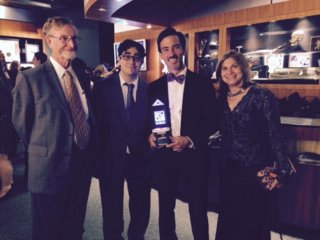
Photo by Bill D’Agostino of Act II Playhouse
Setting: Ambler in Winter. 50 years in the future. Lulu, a girl, and her grandmother, on top of a hill with a sled.
GRANDMA: Do you know the story of this hill?
LULU: No.
GRANDMA: Your granddad and I met here. We were kids, not much older than you.
Back in those days, kids used to sled down this hill. Even when it wasn’t winter.
LULU: Huh?
GRANDMA: You see, below this snow is a lot of dirt and plants. And below that dirt is a white substance known as asbestos. It’s also white, like snow, and you can sled down it. And we used to, when we were kids. Your granddad and I. Your great-grandad, your grandad’s father, worked in the factory that made the asbestos. But then they shut down the factory, and we couldn’t sled here anymore.
LULU: Why?
GRANDMA: Asbestos can be dangerous. Some people who worked in the factory got very, very sick.
That’s a scene from “The White Mountains,” a play performed over the summer by actors from the ACT II Playhouse, to educate residents of West and South Ambler, Pa., about the potential health risks of the 100-year-old asbestos manufacturing industry in the town. There are many valuable tools to reach out to the public about these issues, such as brochures, town halls, and social media, but Ambler, Pa., experienced a more dramatic approach—with theater.
It was part of a larger project under the
Center of Excellence in Environmental Toxicology (CEET) and the
Perelman School of Medicine, which
received $1.2 million from the
Science Education Partnership Award (SEPA) and the
National Institutes of Health to develop educational materials and programs to inform community residents about the risks associated with asbestos exposure.
The Penn team first partnered with the Chemical Heritage Foundation to form REACH (Resources for Education and Action for Community Health) Ambler to develop a website, publications and an exhibit chronicling the story of asbestos in the town. The team then collaborated with Bill D’Agostino, communications and education director of the ACT II Playhouse, and 10 Philadelphia playwrights to use 20 recordings of life histories from community residents, to inspire one act plays portraying Ambler’s past, present, and future.
The performances, produced by and performed at the theater in Ambler, served as a unique channel to share their message throughout area neighborhoods.
This sold-out performance, titled “The White Mountains,” referring to the name given to the area in Ambler after the appearance of asbestos, also included live original music and a lively post-show dialogue among audience members—including Ambler residents, oral history interview participants, and local government officials—and REACH Ambler project staff and faculty.

Dr. Edward Emmett, (Penn), Bill D’Agostino, (Act II Playhouse), Dr. Jody Roberts (Chemical Heritage Foundation), and Dr. Frances Barg (Penn)
“The purpose of the plays was to foster conversation among community residents about the diverse ways that asbestos exposure has affected the community,” Frances Barg, PhD, MEd, an associate professor of Family Medicine and Community Health at Penn Medicine and principal investigator for the project, explains. “It has been a powerful communication tool that we hope to replicate.”
The team's production also recently garnered a Philadelphia Geek Award for their innovative approach to public health education.
Since 2011, the annual Philadelphia Geek Awards honor outstanding achievements by passionate creative individuals throughout the Greater Philadelphia region. The selection committee spans a range of professionals as wide as the award categories themselves, including those in film, technology, journalism, and science.
Dating back to the late 1880s to now, many residents of Ambler have experienced occupational or environmental exposure to asbestos resulting in potentially serious long-term health consequences. The Pennsylvania Department of Health notes an increase in mesothelioma in the area compared to Pennsylvania as a whole, and Penn Medicine researchers are exploring the implications of that higher rate.
The Penn Superfund Research and Training Program is also continuing its work in conducting multiple investigations into concerns that community members have expressed.